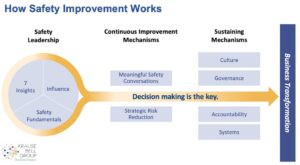June 3, 2022
How Safety Improvement Works
As a business leader, how would you approach a major change in business strategy? Would you delegate the topic to a functional department to create some tactical activities and implement them? Or would you discuss and align across senior leadership on vision and objectives and develop a strategy together? Probably the latter. How would you then lead the implementation of the change? Would you rather focus on key issues or on general items?
Working with companies to prevent workplace injuries, we learned that safety improvement works the exact same way. Moreover, safety is the ideal topic to build relationships across the entire employee population and lay the foundation for organizational excellence. This article is the first in a series focused on How Safety Improvement Works. It will help you design a safety improvement strategy that delivers tangible results to workers, leaders, and shareholders alike.
How Safety Improvement Works
Safety improvement starts with leadership and unfolds from there. This needs to begin with the highest level of leadership in a given organization and cannot be delegated.

- Safety Leadership is a uniquely powerful starting place for business transformation. This is because when an organization takes on the challenge of safety improvement by developing safety leadership capability, two things happen: Safety improves and the business benefits from a culture in which people are highly motivated and thriving.
In our experience, safety transformation has broad and enduring impacts on productivity, quality, and safety, which means–if done in the right way–there should be no conflicts of objectives. - The two Continuous Improvement Mechanisms describe general capabilities every organization needs to function well in order drive out exposure to risk. Meaningful Safety Conversations surface information about risk, while Strategic Risk Reduction invokes collaborative problem solving to solve difficult problems. We will talk about this in Part 2 of this series. Only a little spoiler: It is about preventing SIFs (serious injuries and fatalities).
- Sustaining Mechanisms like culture, governance, organizational systems, and accountability are crucial to maintaining achievements, but do not generate results by themselves. Culture is very special in that it is created automatically when you lead with safety. We will have more to say on this in Part 3.
- Decision Making is the key. An important factor that runs through it all is organizational decision making. To what extent is safety considered and built in when making operational decisions? Are leaders even aware that their decisions may impact safety and in what way? During a study we carried out a couple of years ago, we found for example that the vast majority of decisions that impact SIFs are vulnerable to cognitive bias. We explore this further in a future article as well.
How Leaders Drive Safety Improvement
Safety improvement starts at the top and with alignment on the vision, objectives, and strategy for safety improvement. This means to align on WHY we want to change, WHAT we want to achieve by when, HOW we want to get there, and HOW do we as Leaders want to act and behave. In order to effectively instill change and drive improvement, we recommend developing a strategy based on the 7 Insights into Safety Leadership, using superb influencing skills and building knowledge of fundamental safety concepts.
Let the Insights Inform your Improvement Strategy
The 7 Insights into Safety Leadership provide a great foundation for your safety improvement strategy. If you incorporate these insights, the culture that you create alongside the improvements you make in safety will deliver all kinds of benefits to your firm. Your people will thrive, and that will infuse energy across your business.
Optimize Interpersonal Influence
Leaders are constantly influencing the thinking and the behavior of the people around them, even when they don’t realize. For example, if I as a leader walk by an unsafe situation without recognizing and addressing it, I am still sending a message about the importance of safety, even if not intended. So, I need to behave in a way that supports what is being communicated–all the time. We as leaders will be most successful and effective in setting the right tone and conveying the value for safety if we have the right influencing skills. A great way to start working on this is to consider the following three questions when interacting with people:
- What do I want the people I am talking to, to know about how I feel about safety?
- How do I want them to feel themselves?
- What do I want them to tell others about the interaction with me?
This way we can be more certain that our message will not only be conveyed but also accepted and internalized.
Build Knowledge of Safety Fundamentals
Finally, leaders should understand enough about safety fundamentals to be able to make informed decisions and act in a way that supports the safety culture. Far too often, a single day of well-intended actions can destroy months and years of efforts because fundamental knowledge about the meaning of incident data, leading indicators, the safety of the workplace, and the role employee involvement plays is not present. It is also important to understand what precursors are leading to major incidents and SIFs. This is all about knowing what we know and also, what we don’t know.
Read the second article in this series: Continuous Improvement through Meaningful Safety Conversations and Strategic Risk Reduction
How Safety Improvement Works
June 3, 2022
By Thomas Meier & Kristen BellShare this post:
Search for articles


